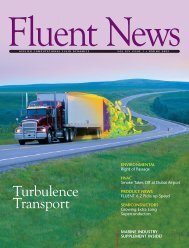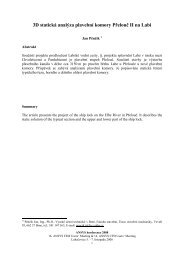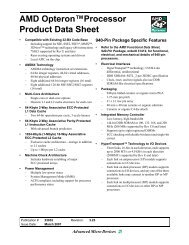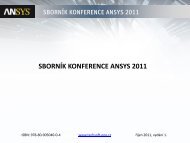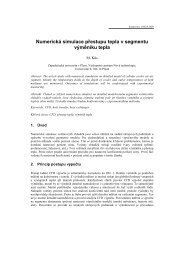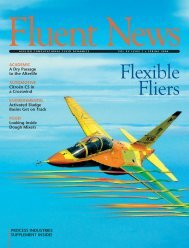Wind Turbine
Wind Turbine
Wind Turbine
Create successful ePaper yourself
Turn your PDF publications into a flip-book with our unique Google optimized e-Paper software.
wind energy<br />
In the Wake of a<br />
<strong>Wind</strong> <strong>Turbine</strong><br />
by Thomas Hahm and Jürgen Kröning, TÜV Nord e.V., Hamburg, Germany<br />
Many companies throughout<br />
the world have been<br />
applying their skills and<br />
expertise to the development of<br />
renewable energy sources. The<br />
number of companies involved in the<br />
production of clean and sustainable<br />
energy will undoubtedly increase in<br />
the near future due in part to a commitment<br />
to the Kyoto Protocol<br />
(1997), which calls for sweeping reductions<br />
in man-made green-house gas<br />
emissions, and in part to an increased<br />
awareness of the environment.<br />
One of the most abundant<br />
sources of renewable energy is<br />
wind, and technology exists today<br />
for the efficient extraction of energy<br />
from wind for power generation.<br />
The efficiency of wind power is tied<br />
to a number of factors, one of which<br />
is the positioning of wind turbines<br />
near other wind turbines or structures.<br />
Decreased distances give rise to wake<br />
effects for the downstream units, which<br />
can lead to changeable wind loads,<br />
reduced energy yield, and vibration<br />
induced fatigue on the rotors and<br />
potentially on nearby power lines.<br />
One popular operation concept<br />
for wind turbines allows for adjustments<br />
in the blade pitch to deliver<br />
a reasonably constant power output<br />
when there are variations in the wind<br />
speed. The wake behind these socalled<br />
“pitch-regulated” wind turbines<br />
depends on a number of parameters,<br />
such as blade geometry, pitch<br />
angle, and rotor speed on the hardware<br />
side and wind velocity, turbulence<br />
characteristics, and wind<br />
gradients on the environmental<br />
side. The large number of governing<br />
parameters makes it difficult to<br />
judge whether wake influences will<br />
lead to loads not considered during<br />
the original construction process.<br />
In a recent series of simulations at<br />
TÜV Nord e.V., FLUENT has been used<br />
to examine the wakes behind wind<br />
turbines of this type on the basis<br />
of their geometry and operating<br />
characteristics.<br />
TÜV Nord e.V. is one of Germany’s<br />
Technical Inspection Agencies and<br />
has the goal of protecting humanity,<br />
the environment, and property<br />
against detrimental effects caused by<br />
technical installations and systems of<br />
every kind. To this end, it promotes<br />
the economic installation or manufacture<br />
and use of technical equipment,<br />
production, and operating<br />
facilities.<br />
In a typical simulation, approximately<br />
650 data points are used to<br />
create the geometry of a single rotor<br />
blade. A fine grid on the whole rotor<br />
surface is used to create a volume<br />
Velocity contours behind one turbine show the<br />
wake effect on a second, smaller turbine<br />
Fluent NEWS spring 2002 5




